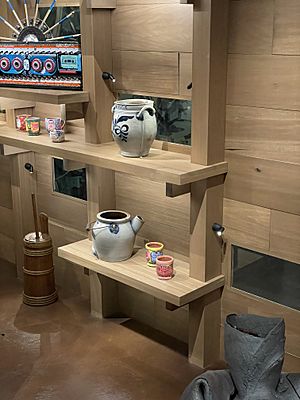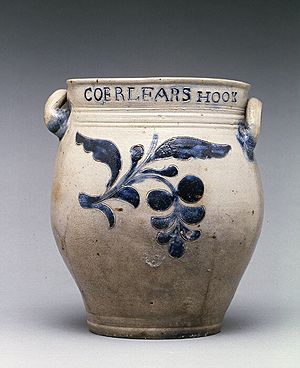Thomas Commeraw facts for kids
Thomas W. Commeraw, also known as Thomas H. Commereau, was an African-American potter and businessman who lived in the early 1800s. He was known for making beautiful pottery.
What's in a Name?
For a long time, people thought Thomas Commeraw's name was spelled "Commereau." This mistake happened because of how his name was written in an old record from 1800. The handwriting was hard to read, and it looked like "Commereau."
Because of this spelling, many people thought he might have been French, especially since his pottery style was similar to European pottery. This simple spelling mistake made it harder for people to understand his true background for many years.
His Career as a Potter
Thomas Commeraw was a talented potter who made ceramics in New York City between 1797 and 1819. He had his own pottery business in a part of the city called Corlears Hook. His pottery was special because it often had pretty blue designs like tassels, scallops, and petals.
Commeraw's pottery containers were used for many things. People stored all sorts of products in them, like oysters, preserved fruit, and even drinks.
In 1819, Commeraw faced some financial problems and had to sell some of his land where his pottery business was located.
In 1820, he decided to leave the United States. He traveled with a group called the American Colonization Society to Sierra Leone, a country in West Africa. Commeraw became a leader in this new colony. He wrote letters back to the Society, sharing updates about how things were going. One of his letters was even published in a newspaper! In it, he described Sierra Leone as a rich and fertile place and seemed hopeful about the new colony.
However, life in the colony was tough. The Society had a lot of control, which limited some of Commeraw's freedoms. In 1821, they made him and others move to a new location. During this journey, Commeraw lost his wife, which was very sad for him and his three young children. After only two years, Commeraw decided to return to the United States.
Today, you can find Commeraw's pottery in many famous places. His works are part of the collections at the Metropolitan Museum of Art, the Brooklyn Museum, the National Museum of American History, and the New-York Historical Society, among others.
In 2022, one of Commeraw's pieces was shown in an exhibition called Before Yesterday We Could Fly at the Metropolitan Museum of Art. In 2023, the New-York Historical Society will have a special show just about him, called Crafting Freedom. It will be the first time an entire exhibition is dedicated to his work alone!

Pottery Style
Thomas Commeraw's pottery style was similar to a German way of making stoneware. This style was brought to New York by families like the Crolius and Remmey families. They came from a region in Germany famous for stoneware. These families were connected by marriage and became very important potters in New York for many years.
They set up the first pottery kiln in New York. They continued the German tradition of making stoneware with a special salt-glaze, blue paint, and carved flower designs. Commeraw later used similar techniques.
It was common for pottery workshops to use many different workers. Some of these workers, including enslaved individuals, were trained in the German pottery style. Being skilled in a craft like pottery made these workers very valuable.
Many of Commeraw's pottery pieces have a location carved into them, like "N*York" (which means New York) or "Corlear's Hook," the neighborhood where he worked. You can see examples of his work at the Metropolitan Museum in New York City and the Smithsonian National Museum of American History. Many of his jars are also bought and sold by private collectors.
Most of the jars that Commeraw marked with his own name are storage jars. He also made oyster jars for another African-American merchant named Dave Johnson.


